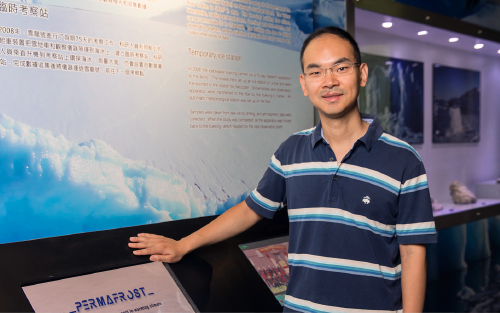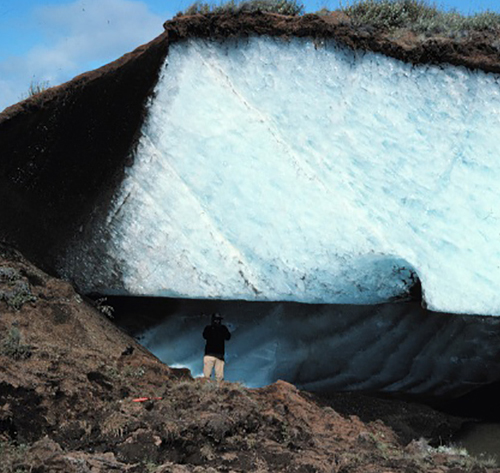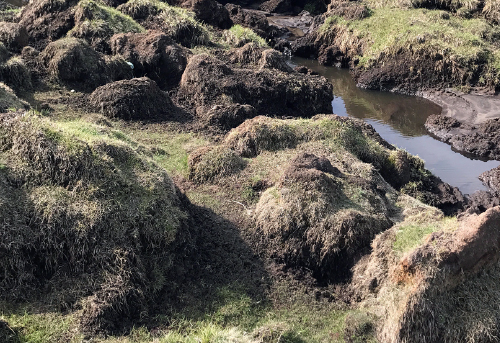Impermanent Permafrost
Global warming has become increasingly a matter of public concern in recent years. Apart from melting glaciers that contribute to a rise in sea levels, global warming also causes extreme weather, which affects human health. A further crisis is now approaching, which is invisible to us because its effects are underground—the thawing of the earth’s permafrost.

Permafrost is soil that keeps frozen for more than two consecutive years. It covers about one quarter of the land area of the northern hemisphere and is found mainly in the polar regions and in high altitude areas. Permafrost stores large amounts of carbon, in forms of organic residues of dead plants and animals which have been frozen for thousands or tens of thousands of years. Scientists estimate that permafrost regions contain about half of the world’s underground organic carbon (1). Once the permafrost starts to thaw as a result of global temperature rises, microorganisms will decompose the carbon and will possibly release the carbon content in the form of carbon dioxide and methane (greenhouse gases) into the atmosphere. This process will produce a vicious circle which will accelerate the pace of global warming.

Professor Liu Lin, an Assistant Professor in CUHK’s Earth System Science Programme, has made a deep study of the permafrost problem. His research focuses on collecting data and develop ways of predicting where and how permafrost is thawing, as well as the likely impacts of this process. Scientists believe that the release of greenhouse gases caused by the long-term thawing of permafrost will increase the level of global warming by the end of this century by 0.2℃ (2). Will this produce a substantial rise in global temperatures? Professor Liu thinks it is too early to say. Permafrost thaws at a relatively slow rate, but this rate varies in different locations. The problem and impact of thawing permafrost should not be neglected.
Professor Liu also points out that the thawing of permafrost will affect human health and the natural environment in various ways. First, thawing of permafrost will release the chemicals stored (such as mercury) into the earth’s seas and rivers, causing water pollution (3). Second, frozen ancient bacteria and viruses will become active again, affecting human health. Third, thawing of permafrost will also make the ground unstable in the regions where it occurs, increasing the risk of geological hazards such as landslides and land subsidence. This instability will pose a grave threat to the safety of regions whose buildings and infrastructure are built on permafrost, for example the Tibetan Plateau.

Scientists can use remote sensing techniques and field measurements to monitor ground surface movements in permafrost regions. We can also use computer models which employ a range of environmental data to simulate changes to ground temperatures, surface vegetation, and underground water and gas deposits. These observations can help scientists to predict what will happen to the earth’s permafrost.
Some engineering methods can be used to lower ground temperatures, such as installing temperature regulators underground. However, permafrost covers such a wide area of the earth’s surface that such measures will have little effect. “A crisis is imminent,” said Professor Liu, “and the only solution is to halt or reverse global warming. Everyone should try to reduce their daily carbon footprint by practising a low-carbon lifestyle.”
A global effort is needed to deal with climate change.
References
- Tarnocai, C., J. G. Canadell, E. A. G. Schuur, P. Kuhry, G. Mazhitova, and S. Zimov (2009). Soil organic carbon pools in the northern circumpolar permafrost region, Global Biogeochem. Cycles, 23, GB2023, doi: 10.1029/2008GB003327.
- MacDougall, A. H., C. A. Avis and A. J. Weaver (2012). Significant contribution to climate warming from the permafrost carbon feedback, Nature Geoscience, 5, 719–721, doi: 10.1038/ngeo1573.
- Rydberg, J., J. Klaminder, P. Rosén, and R. Bindler (2010). Climate driven release of carbon and mercury from permafrost mires increases mercury loading to sub-arctic lakes. Science Of The Total Environment, 408(20), 4778-4783, doi: 10.1016/j.scitotenv.2010.06.056.








